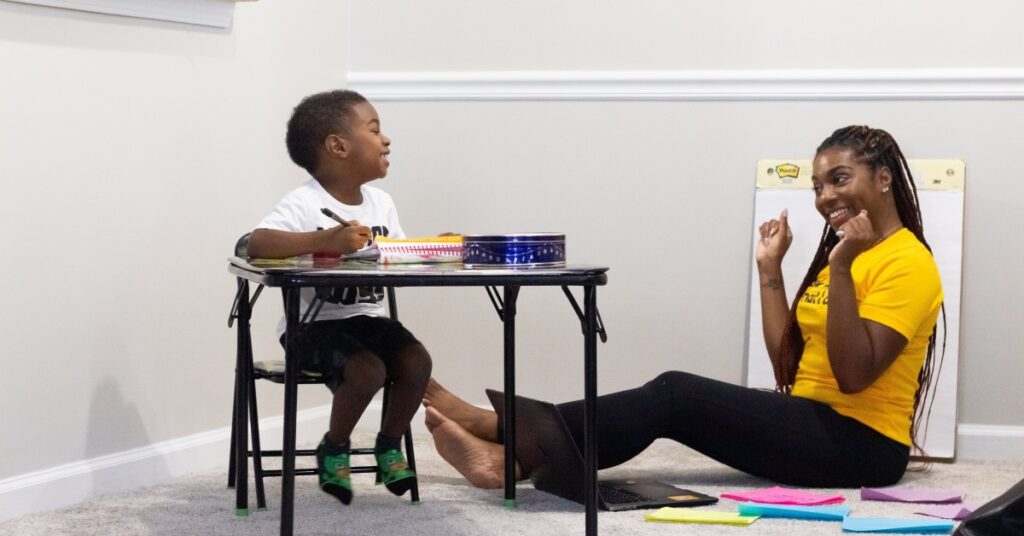
What Is a Master of Library and Information Science?
all LIS professionals must be information-literate. They can work in [...]
![How to Use Zoom for Online Teaching [Step 1: Ask What’s Been Lost]](https://resources.noodle.com/wp-content/uploads/2023/11/pacific-office-interiors-H0rH1ooIsYk-unsplash-1024x536.jpg)
This website may earn a commission if you make a purchase after clicking on a product link in this article
Few authors begin by acknowledging that their subject has already been covered ad nauseam. Even fewer admit that they know their readers don’t want to read it, anyway. Dan Levy does both in his introduction to Teaching Effectively with Zoom, a practical guide to engaging online students and helping them learn, published at what some (wrongly, it turns out) believed to be the height of the COVID-19 pandemic.
As remote workforces fumbled to address poor online etiquette, domestic background noise, and traitorous internet connections, students and educators were similarly forced—many for the first time—into online learning. Typically, universities choose to go online only after a months-long period of planning online curriculums, tailoring platforms for functionality and accessibility, and training educators to use Zoom for breakout rooms, group work, polling, and more. But choice was not a factor in March of 2020 as educators gazed apprehensively into webcams, clueless as to the expectations of the students looking back at them.
“Most people reading this book did not choose to teach online,” Levy writes, confessing that despite his decades of experience in higher education and asynchronous online learning, he, too, is new to live online teaching. For over 15 years, Levy has inspired future policymakers at The Harvard Kennedy School, where he’s currently a Senior Lecturer in Public Policy and faculty director of the Public Leadership Credential, the school’s flagship online learning initiative. In 2019, Levy received Harvard’s Innovations in Teaching award for building a learning culture. He not only leveraged educational technologies; he helped developed new ones like Teachly, a software that tracks student participation and creates data to help close the gender gap in classrooms. His teaching was featured in Invisible Learning, a recent book by David Franklin that “reveals the secrets behind one of Harvard’s most successful statistics courses.” Levy understands what’s at risk when real-time, face-to-face learning flips without warning or preparation to Zoom.
“While many educators and education leaders might rightly encourage us to see the opportunities brought about by online learning, I think it is hard to do this without first acknowledging the loss,” Levy writes. He says that teaching is a profoundly human experience. Not being in the same physical space as his students is a loss he feels deeply. Put two people in a room and you create a shared human experience; move classrooms online and you diminish—perhaps lose—spontaneity. Lightbulb moments—when a class collectively brightens at grasping a difficult concept, or when laughter washes over the room for reasons that can’t be explained—are muted.
Fatigued by voluminous, fragmented information about online learning in response to COVID, Levy created a roadmap for leading virtual classrooms. A “survival guide” praised for its “nitty-gritty advice,” Levy’s book reads less like a manual for online teaching and more like a manifesto for prioritizing humanity in one’s work. Teaching Effectively with Zoom applies to managers as well as teachers. Anyone in leadership (educational or not) would be wise to snag a copy.
For most instructors and faculty, if you ask them, “Is teaching the same thing as learning?” they’ll say, “Of course not—teaching is one thing, and learning is another thing.” But I think we spend a lot more time worrying about our teaching than about our students’ learning. Yes, what matters is the students’ learning, but when you see how we spend our time preparing, I don’t think we take that proposition as seriously as I believe we should.
Teaching is under your control. You can control how the PowerPoint looks. You can control what you are going to say. You can control lots of things, but you cannot control student learning. You can hopefully do something to stimulate it. I heard once this saying that I love, which is “teaching is not about what happens in your head but what happens in your students’ heads.” When we’re teaching, we are thinking about what we are going to do as teachers and we think less of what our students are going to do. I think it’s a natural human tendency, so I tried to bring it back to the book.
Initially, I thought my audience would be mostly college and university faculty members, or anyone with a teaching-related job at a university because I teach at a university. But because I saw what my daughters were experiencing—they are in high school—I realized that some of the challenges were the same. A few friends who work in K-12 told me that they felt it was helpful not just for higher-ed, but also for elementary school and high school. Probably, the book is most beneficial for grades 4 through 12 and post-secondary. I would say a big part of the direction does assume that the learner has some independence and is able to type on a computer.
In my teaching, I had been doing things online—mostly blended learning, producing videos, and online modules that students would engage in before class—and I would leverage that in the classroom. I’ve been doing this kind of teaching for ten years now, but I confess that I didn’t have as much experience with live online instruction.
The Public Leadership Credential is an online program mainly delivered in an asynchronous way, so I was very used to thinking about engaging the learner when you’re not in a synchronous capacity. I had a lot to learn.
My first instinct was to observe my colleagues. I’ve always felt that observing others is one of the best ways to improve, but observing a Zoom class is a dream because it’s the easiest thing possible. You just ask someone for a Zoom link, permission to observe, and then, from the comfort of your home, you’re observing a virtual classroom.
When I saw what my colleagues were doing and, frankly, when I saw the creativity and how they were essentially trying to conquer the constraints that they were facing, I realized some of what I was observing should be out there for others’ benefit. So the book is partly based on my own teaching experience and partly on what I have learned from others that I was observing.
I also spoke with lots of students, and that was an incredibly grounding experience because you would hear some faculty members say, “I do this, and it’s great!” But then you would ask the students, and they would often bring an entirely different perspective. It’s about their learning experience—not about our teaching experience.
As I was preparing to do a video for an asynchronous session, I stumbled into recordings from the previous year, and I realized how much of a profoundly human experience that was. I was at the front of the room, and I would say something. Maybe a student from one side of the room would react and a student on the other side of the room would laugh about that reaction, and there would be something that I cannot explain in any way other than it’s shared human experience when you put people in the same physical space.
Some, but not all. I realized this semester that I miss the sound of the classroom. Being aware, and everyone listening to what might happen in the room, I’ve been trying desperately to recreate that. In a typical live online class, you mute participants if there are more than a handful of people. And, you know, they are on mute for good reasons.
One of the things that I’ve been trying to do this semester is to have points in the conversation where I feel like we would all benefit from hearing the room, and I say, “for those of you who are in a place where you can unmute yourself, now please do so.” But even that doesn’t completely help because Zoom tries to prioritize one voice—so if there’s collective laughter in the room, you don’t hear the collective laughter. You just hear the loudest laugh, maybe followed by the next one. Those are things that I miss.
Frankly, what I miss the most is the kind of spontaneous relationships or aspects of the relationships I could have with my students. I think here you have to be a lot more intentional and deliberate to create those relationships. I am not saying that the physical experience is superior to the online experience in every aspect. The more I have taught, the more I realize certain aspects of online learning are better. And that has been super-interesting to think about the comparative advantages of each medium.
In the book, I share five ways students engage in class: speaking, voting, writing, working in groups, and sharing their work. Speech is how I feel the physical classroom is most superior to the online classroom because speech is just not as natural. In the book, I go through some of the technical issues that make dialogue a little less natural online.
Of the five ways students engage, there are two in which I feel like online is better: group work and writing. For group work, Zoom has a breakout room feature, and I think it’s better than when you have students working in small groups in a physical classroom—for several reasons. One of them is you might end up having students who would never have spoken or interacted with each other if left to their own devices. And now they do. I think that has enormous benefits.
If you pair this with collaborative tools like Google Slides, you can see the students’ process in real-time, as opposed to when you are in a classroom you approach one group and can barely hear what they are saying. The example I give in the book is: You have 12 Google Slides for 12 groups. If one group seems to have finished this slide, but another group doesn’t even seem to have started it, I’m going to check-in with that group to see what’s going on.
The other way that I think online learning is better is with writing. In a physical classroom, students participate verbally, but they rarely type in a way that the instructor can see. The use of chat in Zoom meetings is controversial, but, if well-used, it can be powerful.
In chat, suppose you end every class two minutes early and ask students, “What is your main takeaway from today’s class? What did you learn?” Within two minutes, all students have told you what they feel they learned. It’s incredibly valuable.
In any endeavor that involves other people, I think you would do well to think about the human side. Teaching involves students, and having empathy for your learners is fundamental for that.
In some way, I believe leadership involves people mobilizing for a certain purpose. Understanding and having empathy for the people you would like to help mobilize toward that purpose is fundamental to the enterprise.
And I’m not a softy here, saying that all that matters is the human touch and that the other stuff does not matter when you lead in an enterprise. I get that you have to achieve results, but I think understanding the human side and need is fundamental to leading effectively.
In the same way that teachers miss the physical classroom, I presume the same has happened across many organizations. There’s a lot of human interaction that occurs very spontaneously when you are all in the same office. Right now, that does not occur.
How do we recreate it online? I think the one lesson I would draw is that you have to be a lot more deliberate. When you have a meeting in an office, people chat before the meeting starts. After the meeting ends, maybe they go for coffee. None of that is happening right now, so unless you are deliberate in creating those interactions, they might not happen. Therefore, the human connection that I think is fundamental to any enterprise might not be as strong online as it needs to be.
This interview has been edited for brevity and clarity.
Questions or feedback? Email editor@noodle.com

all LIS professionals must be information-literate. They can work in [...]

Elective courses can customize your MLIS degree to a career [...]

Do you intend to work in your community's public library [...]

For decades now, libraries have been attuned to new developments [...]

A more diverse teacher workforce could provide a key to [...]
Categorized as: Online Teaching, Education & Teaching